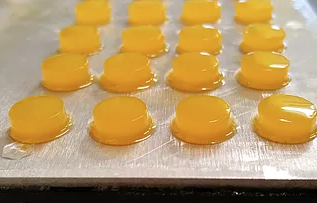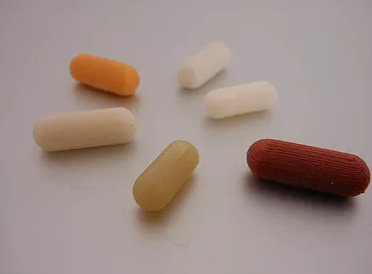3D Printing Customized Printlets Creates Personal Pharmaceutical Solutions — A Few Questions For: FabRx
 Some medications don’t require a spoonful of sugar to go down easier — just 3D printing them into customized shapes and formulations might be just what the doctor (very literally) ordered. We’ve been keeping up with the latest introductions on the 3D printed medicine front for some time now, including the introduction, FDA approval, and commercialization of 3D printed epilepsy pills and the work from University College London’s School of Pharmacy spinoff, FabRx. Research is increasingly proving the efficacy and accuracy of 3D printed medications that can deliver the perfect formulation, showcasing an important future use of 3D printing technology, which is making its way into our bodies in an increasingly interesting (and invasive) variety of routes.
Some medications don’t require a spoonful of sugar to go down easier — just 3D printing them into customized shapes and formulations might be just what the doctor (very literally) ordered. We’ve been keeping up with the latest introductions on the 3D printed medicine front for some time now, including the introduction, FDA approval, and commercialization of 3D printed epilepsy pills and the work from University College London’s School of Pharmacy spinoff, FabRx. Research is increasingly proving the efficacy and accuracy of 3D printed medications that can deliver the perfect formulation, showcasing an important future use of 3D printing technology, which is making its way into our bodies in an increasingly interesting (and invasive) variety of routes.
 I recently talked with Dr. Alvaro Goyanes Goyanes, Director of Development at London-based FabRx, to learn more about their Printlets — that’s 3D printed tablets — that the company has been working toward through examining several different over the last few years.
I recently talked with Dr. Alvaro Goyanes Goyanes, Director of Development at London-based FabRx, to learn more about their Printlets — that’s 3D printed tablets — that the company has been working toward through examining several different over the last few years.
“Our novel Printlets technology offers a proprietary platform technology to formulate and manufacture 3D printed medicines with nearly any drug compound,” FabRx says. “FabRx technology allows manufacturing of Printlets with a diverse range of shapes, sizes, colours, textures and flavours to make them more attractive to various patient groups, particularly the young or the elderly, facilitating compliance of the treatment.”
 Printlets from FabRx hold great promise in precision, in that dosage can be changed with each pill, allowing for personalized medicine and either high or low concentrations of drugs. It is also possible, FabRx notes, “to incorporate multiple drugs within one Printlet, to make fixed-dose combinations,” making possible even greater targeted dosing. They are working with pharmaceutical excipients that meet GRAS (generally recognized as safe) standards seen in medications, the selection of which enables FabRx to design for a variety of drug release profiles, ranging, they say, “from immediate release to sustained and delayed release (including zero-order).” Tests for the drug release conditions are “performed in a Dynamic Dissolution Model that modulates pH over time, precisely mimicking gastro intestinal conditions during transit.”
Printlets from FabRx hold great promise in precision, in that dosage can be changed with each pill, allowing for personalized medicine and either high or low concentrations of drugs. It is also possible, FabRx notes, “to incorporate multiple drugs within one Printlet, to make fixed-dose combinations,” making possible even greater targeted dosing. They are working with pharmaceutical excipients that meet GRAS (generally recognized as safe) standards seen in medications, the selection of which enables FabRx to design for a variety of drug release profiles, ranging, they say, “from immediate release to sustained and delayed release (including zero-order).” Tests for the drug release conditions are “performed in a Dynamic Dissolution Model that modulates pH over time, precisely mimicking gastro intestinal conditions during transit.”
The customization possible in each unique Printlet holds the potential for massive advances in modern medicine, especially as so many societies see more and more incorporation of a pharmaceutically-driven lifestyle. Dr. Goyanes provided additional insights, as I had A Few Questions For him to learn more about the technology FabRx currently employs and their plans for bringing their 3D printed medications to market within the next decade.
What types of 3D printing technology are you primarily using for the Printlets?
“FabRx has specialist experience in using all the 3D printing technologies that can be used in pharmaceutics, but focus particularly on fused deposition modelling (FDM), powder bed printing and stereolithography (SLA) to formulate 3D printed medicines. We call our proprietary 3D printed medicines Printlets; they are novel drug formulations that achieve personalised dose and controlled drug release profiles which can be tailored to the individual needs of each drug and that cannot readily be prepared by other manufacturing methods. Our expertise is mainly based on formulation development and knowhow in 3DP technology and drug-excipient characteristics.
The tablets from the pics were done by FDM. We are evaluating other technologies but probably the closest to the market would be FDM. SLA uses excipients that are not GRAS (Generally recognised as safe) so we are still investigating new materials for this technology. Regarding other technologies, due to patent application I cannot disclose much information.”
What sorts of testing/clearance have been done?
“Our novel Printlets technology offers a proprietary platform technology to formulate and manufacture 3D printed medicines with nearly any drug compound with a high control of the dose strength (the main requirement for personalization). FabRx technology allows manufacturing of Printlets with a diverse range of shapes, sizes, colours, textures and flavours to make them more attractive to various patient groups, particularly the young or the elderly, facilitating compliance of the treatment.
We have tested many parameters from the Printlets e.g. hardness, size, shape, drug stability… specially dissolution of the drug. When a formulation is swallowed the drug can be released fast in the stomach (immediate release) or in a controlled manner (e.g. sustained release) to maintain the drug effect for hours. Depending on the drug and its application a proper selection of excipients allows FabRx to design Printlets possessing any desired drug release profile, ranging from immediate release to sustained and delayed release (including zero-order).
We have done in vitro studies and in vivo studies with animals, and we are planning to start studies in humans in a couple of months (data not published).”
 What is the expected time line to bring these fully to market?
What is the expected time line to bring these fully to market?
“There are strict regulatory requirements in bringing pharmaceutical products to market, and the regulators will need to adapt to and accept printing as a method of manufacture. The recent approval of Spritam has shown that this is possible, although the market is not yet at the point to accept individual manufacture of medicines at the point of dispensing. However, we believe that we will be able to develop and commercialise printed tablets within the next 5-10 years.”
What developments does 2017 hold in store for Printlets/FabRx?
“We are promoting the use 3D printing as an alternative manufacturing method in the pharmaceutical industry. As new drugs are developed that have increasing potency and differential effects within populations there is a need to consider new manufacturing methods and novel supply chains to realise the paradigm of personalised medicines. Nowadays medicines are usually manufactured in large scale processes which limit the range of dose strengths available. 3D printing (3DP) has potential as a point-of-dispensing manufacturing technique, but current technology cannot be used to manufacture medicines for human use. In our view 3DP technology will be rapidly developed, optimised and adapted to pharmaceutical manufacture. We are developing the technology for applications that can have commercial viability.”
Printlets’ 3D printing technology holds a great deal of promise, and we look forward to keeping up with this innovative team as they work toward bringing their customized pharmaceutical solution to market. While many remain hesitant regarding issues of liability and legality in pharmaceutical production, science is holding up to affirm the validity of the heavily-tested technological innovations at hand. Discuss in the FabRx forum at 3DPB.com.
[All images: FabRx]
Subscribe to Our Email Newsletter
Stay up-to-date on all the latest news from the 3D printing industry and receive information and offers from third party vendors.
You May Also Like
Printing Money Episode 18: The DC Fly-In with Mark Burnham, AddMfgCoalition
It’s only been a week since the previous show, but Printing Money is back already with Episode 18. Certain events call for Printing Money’s coverage, and the recent 2nd Annual...
3DPOD Episode 199: Collaborative Design with Graham Bredemeyer, CEO of CADchat
About a decade ago, entrepreneur Graham Bredemeyer started Collider, a company that combined the best of 3D printing with injection molding. Now he runs CADChat, which hopes to make sharing...
Printing Money Episode 17: Recent 3D Printing Deals, with Alex Kingsbury
Printing Money is back with Episode 17! Our host, NewCap Partners‘ Danny Piper, is joined by Alex Kingsbury for this episode, so you can prepare yourself for smart coverage laced...
3DPOD Episode 198: High Speed Sintering with Neil Hopkinson, VP of AM at Stratasys
Neil Hopkinson, a pioneering 3D printing researcher, played a pivotal role in developing a body of research that is widely utilized today. He also invented High Speed Sintering (HSS), also...





































